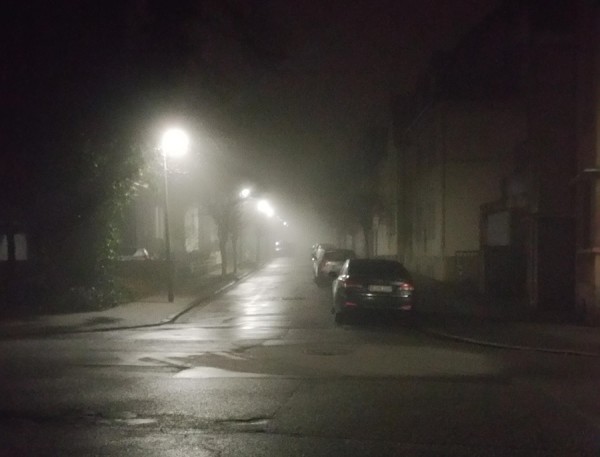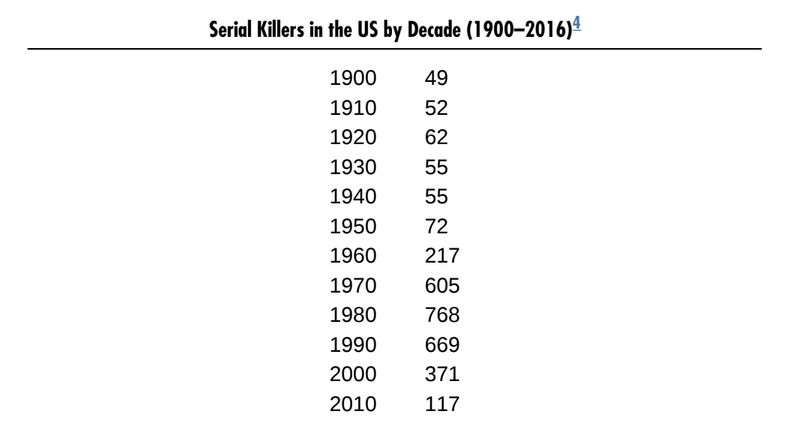How Civilization Decay Produced a Serial Killer Boom
Reading American Serial Killers: The Epidemic Years 1950-2000 by Peter Vronsky, one is immediately struck by the following: most sources blame the rise of serial killing on the new travel options created by our freeways, but few look at how our mental state declined during the world wars.
It seems that most of our serial killers arrived in the postwar years and faded as that generation got too old to rape, murder, dismember, pose, and stash the corpses of their victims:
Of 2,604 identified serial killers in the United States during the twentieth century, an astonishing 89.5 percent (2,331) made their appearance between 1950 and 1999, with 88 percent of those appearing in just the three decades from 1970 to 1999 — the “epidemic” peak years. (7)
It seems these also correlate with wars in other areas as well:
European serial killers continued to make sporadic appearances in the first half of the twentieth century, with a “hot spot” in the chaos and degradation of post–World War I Germany. (21)
Another book makes the connection between war and traumatized children who become killers through a study of PTSD and how it passes on between generations:
The controversial conclusion he reached to explain the 2,065 butchers who grabbed headlines for spilling blood in the second half of the 20th century: A “hidden surge of war-traumatized fathers” returned home from battlefields in Europe and the Pacific and spawned a generation of murderous emotional cripples.
Their fathers were often veterans coming back from that war in a traumatized state. And then just the horror of it began to emerge in these last two decades when we began to see the rate, for example, of rape that our soldiers perpetrated in that war. The statistics are mind-boggling and we’re talking about rapes of women who we were liberating in France, Italy and so forth. And then when we look at the Pacific — where we really had a genocidal war in terms of a war between races — you see acts of ritualistic necrophilia, the taking of heads, the pulling of teeth and the collection of human trophies and you begin to understand just how traumatic that experience must’ve been. And of course, not only for the guys who are perpetrating these things, but anyone who witnessed or heard about it. I’m sure it was a minority of American soldiers who perpetrated these acts, but a large majority of them must have witnessed it.
Vronsky agrees that social cues trigger a sense of permissiveness and desperation:
But in the twentieth century, we began to increasingly see episodes of highly “scripted” extreme pathological and paraphilic serial murder that would characterize the upcoming surge of serial killing. The scripting — “what to do and in what way” — for these murders seemed to originate less from the deep instinctual recesses of the primitive corners of the perpetrators’ brains and more from the social, cultural and historical cues from the society they lived in, from what both popular and transgressive culture celebrated in literature, newspapers and the newly emerged medium of cinema. (34)
Some believe that killers are driven by a sense of justice that was denied to them through abusive or meaningless and paranoid upbringings, a response to trauma between generations:
The serial killer, according to McLaren, rather than being an outcast, is “likely best understood not so much as an ‘outlaw’ as an ‘oversocialized’ individual who saw himself simply carrying out sentences that society at large leveled.” Social critic Mark Seltzer suggests that serial killers today are fed and nurtured by a “wound culture,” “the public fascination with torn and open bodies and opened persons, a collective gathering around shock, trauma, and the wound,” to which serial killers respond with their own homicidal contributions in a process that Seltzer calls “mimetic compulsion.” (122)
War interrupts the order that was, and in its place leave a sense of struggling against internal decay, which makes sense in that for diplomacy to fail, insanity has to have taken root. This creates domestic instability even for the winners:
World War I and its aftermath changed all that. It challenged the notion that duty and sacrifice would be rewarded with real change. A “Lost Generation” of disillusioned and shell-shocked American men returned from the horrors of a “war to end all wars” that did nothing of the sort. In the spring of 1919, as the Allies sat down at Paris and Versailles to draft a peace settlement to create a better world, the United States instead was subsumed in a rising surge of terror, murder and race war. (73)
We can see this in the sheer number of mentally damaged people produced by warfare:
Of American ground combat troops deployed in World War II, an astonishing 37 percent were discharged and sent home as neuropsychiatric casualties. (77)
This manifests in shattered families, in part from wartime trauma and in part from the new independence of women who worked jobs during the war and now see family as optional:
The FBI “mindhunter” study of serial killers conducted in the late 1970s and early 1980s concluded that 66 percent of serial killers reported their mother as the dominant parent, and 47 percent reported their father gone before they reached the age of fourteen.
Indeed, during 1945 and 1946, the divorce rate doubled from what it was in 1939 to an average of thirty-one divorces for every hundred marriages, the highest rate in the world. And the divorce rate among veterans was twice that of civilians. (85)
This new egalitarianism on the part of women leads to alienated families and as a result, alienated men who have become enraged with the conduct of women:
An article in the New York Times in 1946 entitled “The American Woman? Not for This GI” gave voice to the thousands of frustrated veterans coming home to find women transformed:
Being nice is almost a lost art among American women. They elbow their way through crowds, swipe your seat at bars and bump and push their way around regardless. Their idea of equality is to enjoy all the rights men are supposed to have with none of the responsibilities… (86)
The rise of the domineering monther, managerial-administrative state, diversity tensions, and general psychological disorders creates people who feel powerless and consequently retaliate through expressions of power via cruelty:
Dennis Nilsen, convicted in the murder of twelve men in Britain, thought that Lecter was a fraudulent character and said, “He is shown as a potent figure, which is pure myth. It is his power and manipulation which please the public. But it’s not at all like that. My offenses arose from a feeling of inadequacy, not potency. I never had any power in my life.” (289)
As a civilization dies, it drives its population insane through equality, wars for democracy, totalitarianism to enforce diversity, and the red tape that makes life a maze that only the obedient and stupid find comfortable.
Serial killers may be our canary in the coal mine. Their appearance means that far lower on the scale, many ordinary people are also suffering from the trauma of civilization collapse, and acting as illogically even if not as violently.
Tags: civilization collapse, ptsd, serial killers, trauma











